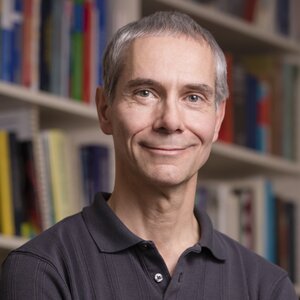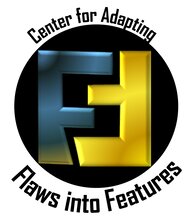There's a saying among programmers who make excuses for flaws in their code: "That's not a bug, that’s a feature!"
A multi-university team that is led by Rice University chemist Christy Landes and includes UIUC chemistry Prof. Martin Gruebele is taking that concept far more seriously in a collaborative effort to optimize materials by exploiting their defects.
The research team has landed a National Science Foundation grant to establish the NSF Phase 1 Center for Adapting Flaws into Features (CAFF). Its goal is to exploit chemical defects that show the potential for unique reactivity to optimize the structural and electronic properties of materials.
The award is a three-year Phase 1 grant for $1.8 million through NSF's Centers for Chemical Innovation Program. It will allow the research team to make its case for a longer-term Phase II award to explore "high-risk" ideas and new approaches toward transformative technologies.
In addition to Landes and Gruebele, the team includes Rice chemists Stephan Link and Peter Rossky, along with scientists from Stanford University, Stony Brook University, the University of Texas at Austin and the University of Wisconsin.
Specifically, the center intends to take advantage of what the researchers call "the messy reality" of microscopic flaws in materials to make better catalysts and coatings and more efficient electronics, for starters.
Gruebele, the James R. Eiszner Endowed Chair in Chemistry, said the idea is a very simple one. Today, people work on bigger and bigger molecules and when you make things bigger and bigger, the chances there will be an error increase rapidly.
“It’s basically impossible to make really, really large molecules that are error free,” he explained. “We actually look at the flaws in large human made materials, nano materials, where you basically build out of hundreds of thousands of atoms. It’s taking these nano materials that people make, and then understanding which errors are good, and which are bad. And can we convert the bad ones into good ones?”
For example, when you look at a gold nanorod in detail at the microscopic level, there are atoms missing and things aren’t perfect.
“And so, it turns out that in some cases when these things are missing, it’s bad,” Martin said. “It hinders the function or poisons the catalyst. But in other cases, that extra atom is actually the thing that makes it work. And it’s the only thing that makes it work. If you had the perfect particle, it wouldn’t have done anything. But we’re pretty bad still at telling the difference when one of those errors is a bad thing and when it’s a good thing. It’s like biology, there might be a mutation, and as a result, it adapts to the environment better.”
Gruebele said one project where a defect becomes a desirable feature is converting a high energy photon from the sun into two low energy photons by splitting it in half. Certain kinds of surface defects help this “singlet fission” process, as it’s called.
“And what that allows you to do is to make solar cells that have better energy utilization efficiency, because you can take some part of the spectrum that normally couldn’t be absorbed and split it into two longer wavelength photons, each of which now can be absorbed and improve the efficiency,” he said.
Flaws can be as simple as a missing atom in a 2D lattice that allows small molecules through, or a mismatched arrangement of atoms at the interface of two materials that affects how electricity flows between them.
"There are tons of examples, not just in chemistry but all sorts of things," said Landes. "One is iron. We like to say something is strong like iron, but the truth is, pure iron is not strong at all.
"It's easily rusted and is too soft in its pure form to be of any use in structures," she said. "But by adding small amounts of impurities like carbon and nickel, you can turn it into an incredible material, steel.
"It's the same on the molecular level," Landes said. "A pure, flat surface with all the chemical bonds satisfied is often not a great catalyst. And silicon without additives would not be the right semiconductor for many applications."
Landes and her colleagues' expertise in advanced microscopy and spectroscopy makes them uniquely suited to characterize molecular reactions with an eye toward optimization.
"We're physical chemists, and in general we don’t make new materials, perfect or flawed," she said. "What we do is study materials to understand how their flaws contribute to their properties. To do that, we need to measure them, image them and take spectra with a level of detail that lets us distinguish the chemistry happening at the defect versus other sites in the material."
She noted co-investigators Gruebele and Jennifer Dionne at Stanford have imaging instruments able to reveal the dynamics of nanoscale objects.
"In order for energy transfer, charge transfer or a chemical reaction to happen, nanomaterials have to go through some higher excited state," Landes said. "Martin's instrument is, to my knowledge, the only one in the world that allows us to do that on real materials with that level of detail."
Incorporating modern theoretical modeling and data science into CAFF will be critical, Landes said, and the center is designed with the convergence of these capabilities in mind.
CAFF will also incorporate outreach to K-12 programs and tap into diverse community college networks near the participating institutions, including Parkland College in Champaign and Danville Area Community College in Danville.
"Our Phase I partner community colleges represent both underrepresented urban and underserved rural communities, allowing us to reach a diverse set of students who can form the future of American science," Landes said.
Amy Nicely (PhD, ’10, Lisy), an Illinois chemistry alumna who’s now a faculty member at DACC teaching chemistry, said the overall goal of the community college outreach component is to both attract and retain community college students in the physical sciences, especially students who are under-represented in the field of chemistry.
A lot of DACC students are first-generation college students, she said, from rural areas where they have not been exposed to chemistry research or science research in general.
“So, this will give them the chance to be exposed to some really exciting chemical research at the beginning of their undergraduate studies,” Nicely said. “It’s a great opportunity for my students to have exposure to some cutting-edge research, and hopefully it’s done in a way that makes it feel accessible to them and something they can see themselves understanding and being part of. Opportunities for my students will include participating in webinars, networking with students from other institutions and conducting summer research at UIUC. It really has the possibility of touching every student who takes a chemistry class at DACC.”
Landes also noted the center also plans a monthly Flaws to Features webinar featuring civic scientists and moderated by students, with topics including history, current science and professional development as well as "hackathons" relevant to CAFF's central research.
"Through a suite of complementary analytical and physical chemical techniques, the collaborative Phase I Center for Adapting Flaws into Features aims to better characterize molecular defects at the atomic and nanoscale, and understand how these defects lead to key properties of the materials, surfaces and interfaces in which they are incorporated," said NSF Chemistry Division Director Dave Berkowitz. "This combined experimental and theoretical approach has the potential to inform how molecular defects can be designed, engineered at the atomic level and exploited to control macroscale-level outcomes, properties and behavior, potentially leading to transformative impacts in the chemical sciences and industries."
Read the grant abstract at: https://www.nsf.gov/awardsearch/showAward?AWD_ID=2124983
NSF Center for Adapting Flaws into Features: https://nsfcaff.org

